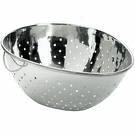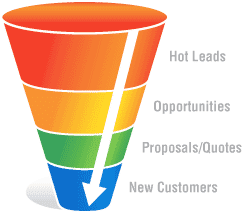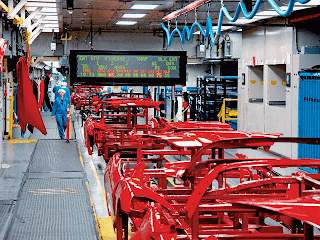

Which of these two items resemble your sales process? Frequently sales consultants, vice presidents and managers refer to their process as a “Sales Funnel” when in fact; it more closely resembles a colander. If 100% of your marketing efforts go in the top and only 10% of them come out the bottom, what is it? A “True Funnel” (it is called “True” per this definition of the word: “exactly or accurately shaped, formed, fitted, or placed, as a surface, instrument, or part of a mechanism.”) will capture all of your marketing generated leads, get them in a structured, strategic process (with solid walls and only two holes), focus efforts and increase the velocity with which they pass through the device. Any seepage will take place at the top of the funnel as overflow spills out.
One can’t simply patch the wholes in a colander and call it a funnel. Both are fundamentally different. Just imagine that you have both a colander and a funnel sitting in front of you with a bucket of water. Pour some water in the colander. The water will go straight through with quite a bit spilling through the side walls. Now pour some water in the funnel. You will quickly notice that the water starts to spin in the top of the funnel, gaining momentum and velocity as it enters the smaller neck area and eventually shoots out the bottom in a more refined stream of water. You should also notice that in order to get more water directly out of the bottom of the colander, you need to increase the amount of water that goes in at the top. Not so with the funnel. The funnel itself either needs to be expanded or the speed of the water needs to be increased in order to get more output.
Let’s look at a traditional sales funnel.
One can’t simply patch the wholes in a colander and call it a funnel. Both are fundamentally different. Just imagine that you have both a colander and a funnel sitting in front of you with a bucket of water. Pour some water in the colander. The water will go straight through with quite a bit spilling through the side walls. Now pour some water in the funnel. You will quickly notice that the water starts to spin in the top of the funnel, gaining momentum and velocity as it enters the smaller neck area and eventually shoots out the bottom in a more refined stream of water. You should also notice that in order to get more water directly out of the bottom of the colander, you need to increase the amount of water that goes in at the top. Not so with the funnel. The funnel itself either needs to be expanded or the speed of the water needs to be increased in order to get more output.
Let’s look at a traditional sales funnel.

You will notice that the leads go in the top and new customers come out the bottom. That is the goal. It is the process of taking an input, interacting with it and getting a completely different output. Naturally there will be some waste in that process, right? The first step in creating our True Funnel is to think of it on a linear level. Define the natural progression from lead to customer. You may include some marketing steps in the process as well if you would like. The True Funnel should include demand generation and other marketing practices.
Now that you have that linear process mapped out, let’s apply some lessons which we have learned from industrialization. The first is specialization. Keep the Sales teams selling. Keep the Marketing teams marketing. How do you bridge the gap? Lead Generation and Lead Qualification teams. Let’s not kid ourselves, sales reps don’t want to become telemarketers. They don’t want to “Smile and Dial”. They don’t want to make more than 30-40 phone dials a day. Which means your leads are not being worked effectively enough. A Lead Gen. or Lead Qual. team can be used to contact new leads within an acceptable time frame and/or continue to attempt contact beyond the standard 3-4 attempts performed by a sales team. Once contacted, that team should simply perform a quick pre-qualification to make sure they are talking to the right person and there is some level of interest, at which point, the lead is sent on to the next station in the assembly line for further fabrication.
The second lesson to be learned is automation.

Look at the picture above. Notice the harmony of man and machine working together to build something wonderful. In an assembly line, machines are often used for repetitive simple tasks, complex precision task, quality assurance, and to report on the status of the line. Technology can be used in similar ways on a sales assembly line. Simple repetitive tasks which can be automated are dialing numbers, leaving voice messages, sending emails, logging activities, scheduling events, and setting reminders. Technology can also be used for precision tasks such as lead capture, lead routing, de-duping, neglected re-routing, immediate response, and campaign strategy.
At a minimum, you should employ some level of analytics for tracking your demand generation activities, a lead response management system for facilitating your response strategies and a customer relationship management solution for managing your pipeline and beyond. It is highly important to have these and other systems communicate or integrate one with another. A key benefit of using technology is oversight and reporting, and if your technologies don’t communicate well, you will lose many key metrics.
Finally we need to address the seepage. If you notice, in a funnel, water that is not ready to leave the bottom stays in a swirling pattern in the top end of the funnel. This is such a perfect metaphor because your leads shouldn’t fall out the sides of your funnel, they should swirl around in the top end until they are ready to slip through the selling end. This is accomplished by nurturing activities. Nurturing activities will take a lead, where its progress is halted, and reinforce it with marketing and educational material. Additional touches by a representative within your organization also help prepare the lead for progression. If these activities are completely automated then the only reason why a lead should ever leave the funnel is if it is disqualified and asked to be removed from any future correspondence at which point it spills out the top of the funnel and stops taking up space.




1 comment:
I have developed a very nice web application to track the 'funnel' activities. Please check on http://www.mis-improved.com. I'm looking for direct customers as well as people who are willing to sell, support and distribute this product.
Post a Comment